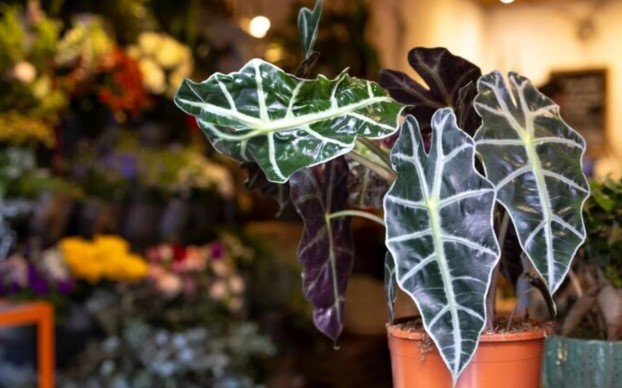
Alocasia, with its showstopper of foliage, is one plant that enjoys a little slice of tropical life. It is very important that you can provide the right conditions to your Alocasia in order for your plant to be healthy and look its best. Everything from lighting, to humidity, to soil composition affects its growth. In this in-depth guide, you will discover how to create the nicest setting for your Alocasia so that it can not only survive but also thrive and beautify your home.
1. A Glimpse Into Their Natural Habitat of Alocasia
Alocasia is native to tropical areas, where it grows in warm, humid climates under the forest canopy. Success with it depends on mimicking these conditions indoors.
2. Need for Adequate Lighting For Alocasia
Alocasia will do best in bright indirect light. The soft foliage can literally get fried if kept in direct sun, and if the light is too subdued it will not grow. Here are the lighting solutions that you should aim for:
- Close to the east or north facing windows
- Sheer curtains act as lenses for sunlight.
- If you are growing in the winter, using grow lights.
3. Optimal Temperature Range
Alocasia may be sensitive to temperature changes. Temperatures that are comfortable for you are ideal for your plant: Keep it in a room, where 65-85°F (18-29°C) temperatures prevail. Keep it away from air conditioners, heaters or drafty windows.
4. Alocasia Humidity: The Key to Alocasia 스타워즈 Life
Alocasia is a high-humidity lover. Humidity should be at least 60% or higher so try to achieve this by:
Using a humidifier.
Adding moisture to the air around it by: – Setting the plant on a pebble tray made with water.
Planting it along with more humidity-loving plants.
5. Choosing the Right Soil Mix
It needs to have soil that drains well but has enough moisture to keep it from going rotten in summer. The ideal mix includes:
- 40% potting soil
- 20% perlite
- 20% Coconut Coir or Peat Moss
- 20% orchid bark
6. How to Water Your Alocasia
The plants could begin to wilt or have yellowed leaves if over/under watered. To maintain proper hydration:
Keep it watered when the top 1 inch of soil is dry
Make sure the pot can drain freely to excess water
Less Bonzi during dormancy.
7. How To Fertilize For Good Growth
A balanced fertilizer during the growing season is beneficial for Alocasia. Tips for fertilization:
Apply diluted liquid fertilizer every 4–6 weeks
Never over fertilize, it may soak roots badly.
Avoid fertilization in winter months when plants are dormant.
8. Choosing the appropriate pot and when to repot
It is very important to use the pot that suits the plant, as the pot type influences its health. Tips include:
Use pots that have drainage dire holes.
Choose terracotta to absorb excess moisture.
Repot every 1-2 years for a soil refresh and root space.
9. Alocasia will also need seasonal adjustments
During winter, Alocasia is likely to exhibit its dormancy by either having slower growth or dropping some of its leaves. During this time:
Less watering, no fertilizing
Place the plant in a cool but bright place.
Resume normal care in the spring when new growth appears.
10. Managing Pests and Diseases
Pests and diseases such as spider mites, mealybugs and aphids are the most common stressors. To prevent and treat infestations:
Check leaves regularly for signs of pests
Treating with neem oil or insecticidal soap.
Maintaining proper wellbeing of the plant to fight against diseases
11. Spread the air and fresh air circulation
Mold and fungus problems are generally avoided with good ventilation. Keep it in an area of good airflow but not where there are drafts.
12. Monitoring Growth and Pruning
To keep the plant looking good and healthy, prune away any damaged or yellowing leaves. Cut cleanly with a perfectly sharp pair of sterilized scissors.
13. Proof & Practice : Propagation and Your Collection Grows
If propagating Alocasia, division of rhizomes is the only means:
Take the plan out of its pot and carefully divide the rhizomes.
Repot them into new pots in the appropriate sterile potting soil.
High humidity to promote new growth
14. Alocasia Display Ideas Alocasia Use Indoors
Celebrate your Alocasia in style.
Show off its dramatic leaves with decorative pots
On a plant stand, as a centerpiece
Add it with the other tropical plants to create the in-house jungle style.
15. A Guide to Common Alocasia Troubleshooting
Problems such as yellowing leaves, wilting, or slow growth are common among alocasia owners. Solutions include:
A: Inspection for pest or disease.
Modifying the moisture and humidity
Providing enough light and nutrition to the plant.
Conclusion
To give your Alocasia the best home which imitates its natural habitat as much as possible, you need to know what this plant like and give it just that. With the right balance of light, humidity, soil mixture and regular upkeep, you will be rewarded with an exotic-looking Alocasia that brings tropical vibes into your home.






